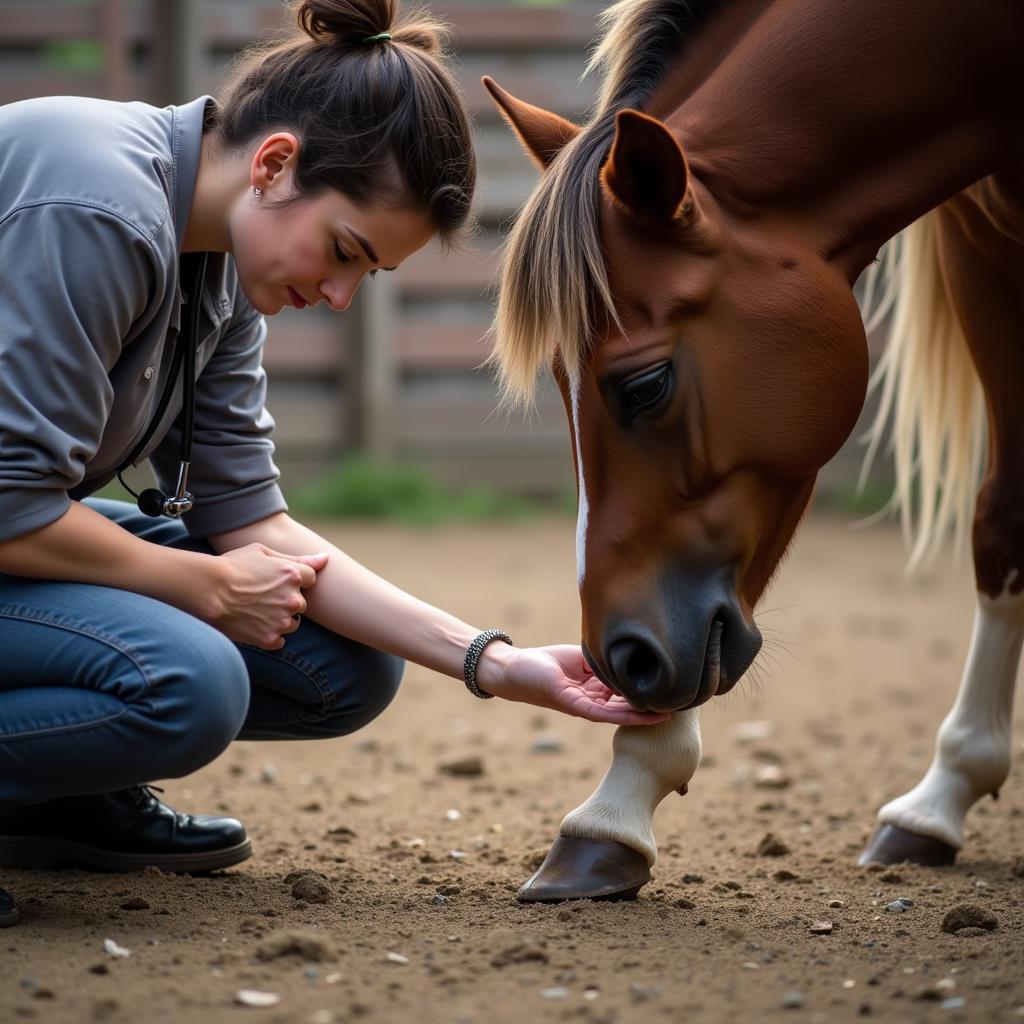Exercising A Horse With Navicular disease requires careful planning and management. It’s crucial to understand that exercise for a horse with navicular isn’t about building muscle or endurance, but about maintaining joint health, improving circulation, and managing pain. This article will guide you through the best practices for exercising a horse diagnosed with navicular disease.
Understanding Navicular Disease
Navicular disease, also known as navicular syndrome, is a degenerative condition affecting the navicular bone and surrounding tissues within the horse’s hoof. It can cause significant pain and lameness, impacting the horse’s ability to perform and enjoy everyday activities.
Key Considerations for Exercising a Horse with Navicular
Several factors need careful consideration when creating an exercise plan for a horse with navicular:
- Pain Management: Effective pain management is paramount. Consult with your veterinarian to determine the best approach, which might include medications, therapeutic shoeing, and other therapies.
- Surface: The surface your horse works on is critical. Hard, uneven, or deep surfaces can exacerbate navicular pain. Opt for soft, level surfaces like well-maintained sand arenas or grass pastures.
- Duration and Intensity: Short, frequent exercise sessions are generally preferred over long, strenuous workouts. Start slowly and gradually increase the duration and intensity as your horse’s comfort allows.
- Warm-up and Cool-down: Adequate warm-up and cool-down periods are crucial for preparing the horse’s joints and muscles for exercise and reducing the risk of injury.
Exercise Options for Horses with Navicular
While traditional riding might be limited, several other exercise options are suitable for horses with navicular:
- Hand-walking: Leading your horse at a walk on a soft surface is a low-impact way to encourage movement and circulation.
- In-hand work: Simple in-hand exercises, like turns on the forehand and haunches, can help maintain flexibility and suppleness without stressing the navicular bone.
- Swimming: Swimming is an excellent, non-weight-bearing exercise that provides cardiovascular benefits without concussive forces on the hooves.
Monitoring Your Horse’s Progress
Regularly assess your horse’s lameness and comfort levels. Note any changes in gait, swelling, or heat in the affected hoof. Communicate these observations to your veterinarian to ensure the exercise program remains appropriate. Remember, each horse is unique, and what works for one might not work for another.
How Can I Tell if My Horse is Experiencing Pain During Exercise?
Common signs of pain include changes in gait, head bobbing, reluctance to move forward, and increased sensitivity in the affected hoof.
What are the Best Surfaces for Exercising a Horse with Navicular?
Soft surfaces like sand arenas or grass pastures are ideal. Avoid hard, uneven, or deep surfaces.
How Often Should I Exercise My Horse with Navicular?
Short, frequent exercise sessions are generally best. Start slowly and gradually increase duration and intensity.
“Consistent, low-impact exercise is key for maintaining comfort and quality of life in horses with navicular,” says Dr. Emily Carter, Equine Veterinarian and Navicular Specialist. “It’s about finding the right balance between encouraging movement and avoiding excessive strain.”
 Veterinarian Examining Horse with Navicular
Veterinarian Examining Horse with Navicular
Conclusion
Exercising a horse with navicular requires a tailored approach focused on maintaining joint health, improving circulation, and minimizing pain. By working closely with your veterinarian and following the guidelines outlined in this article, you can help your horse with navicular live a comfortable and fulfilling life. Remember that patience and consistent effort are essential for managing this condition effectively.
FAQs
- What is navicular disease?
- How is navicular disease diagnosed?
- What are the treatment options for navicular disease?
- Can a horse with navicular be ridden?
- What is the prognosis for a horse with navicular?
- What are the long-term management strategies for navicular disease?
- What kind of farrier work is beneficial for horses with navicular?
Need support? Contact us 24/7: Phone: 0772127271, Email: [email protected] Or visit us: QGM2+WX2, Vị Trung, Vị Thuỷ, Hậu Giang, Việt Nam.